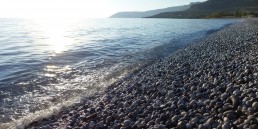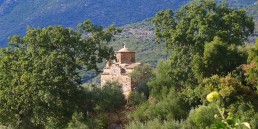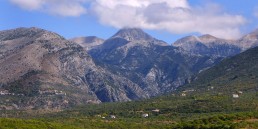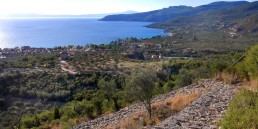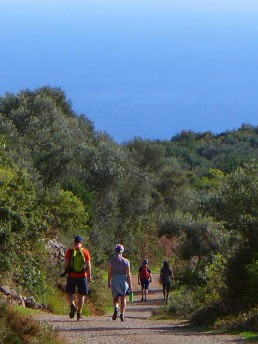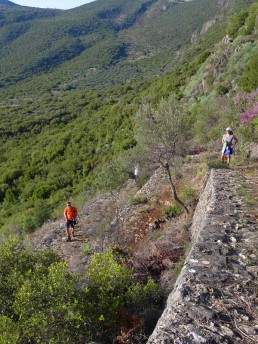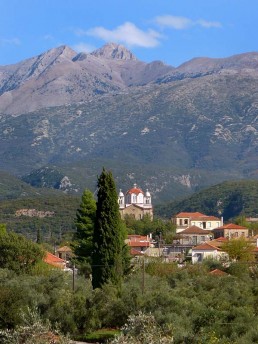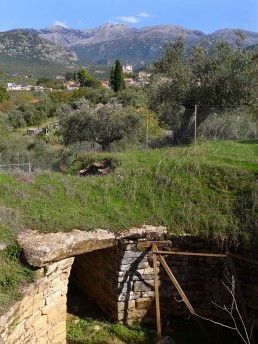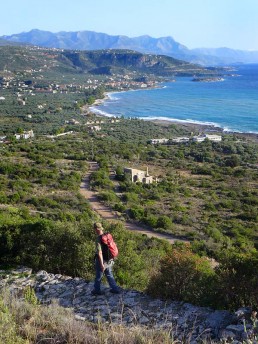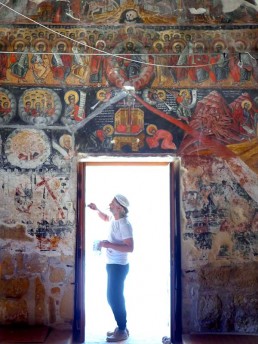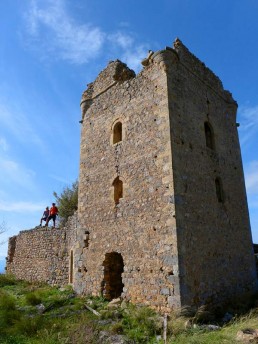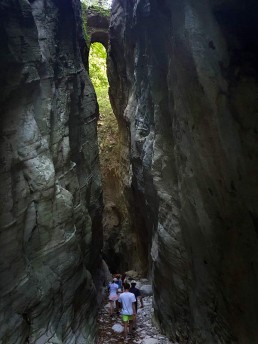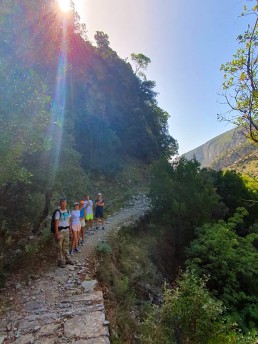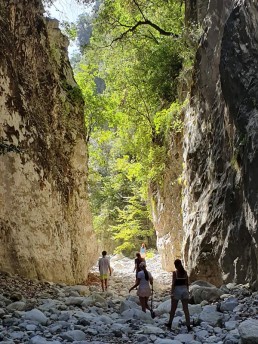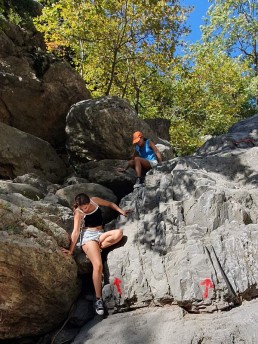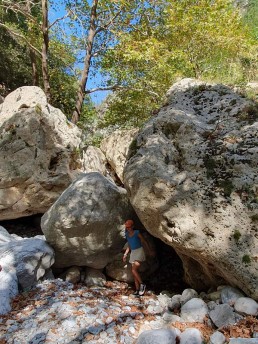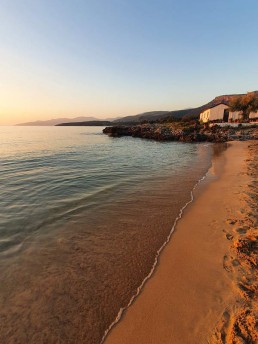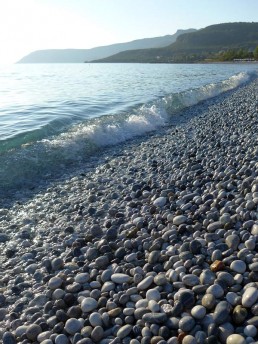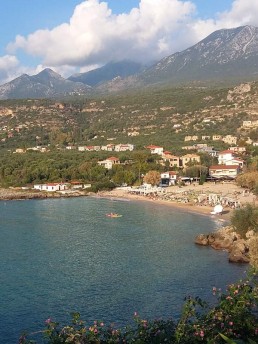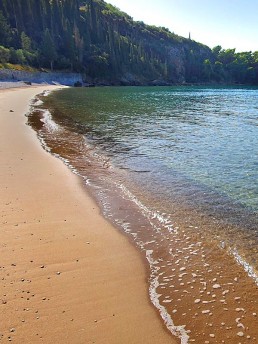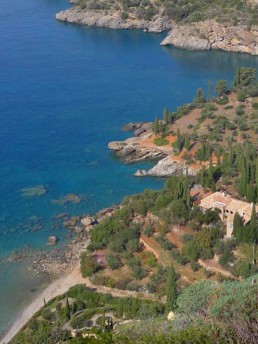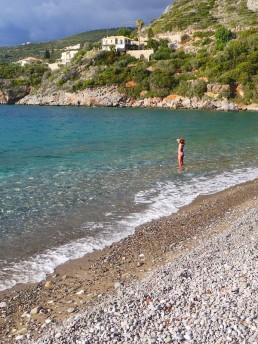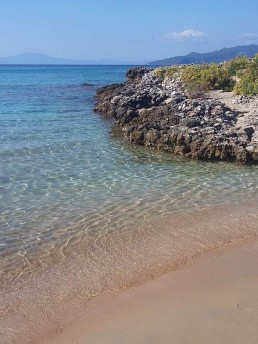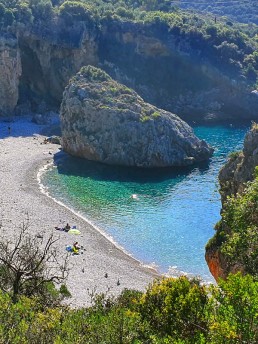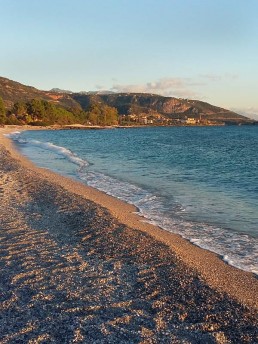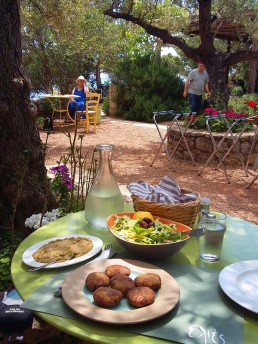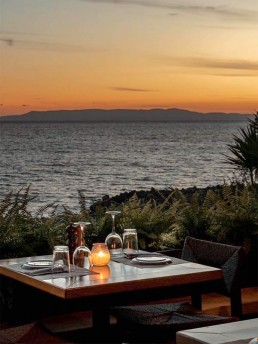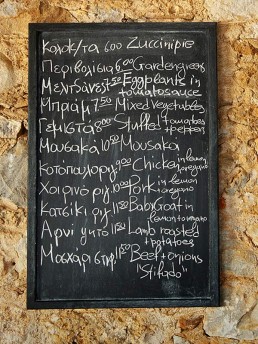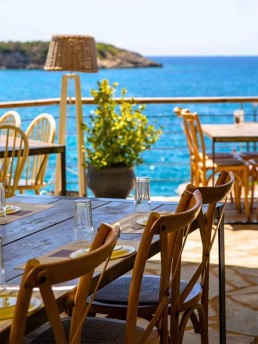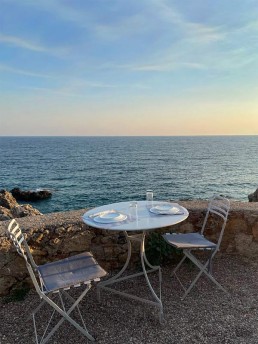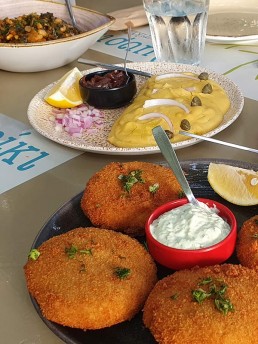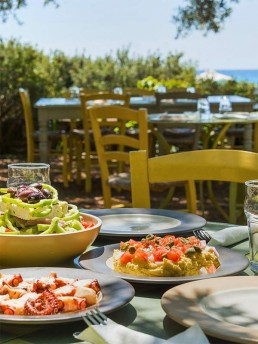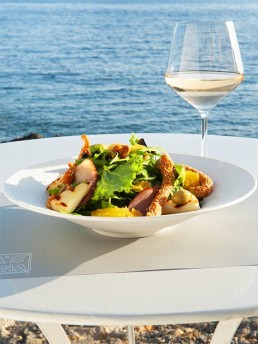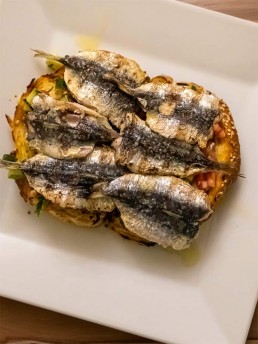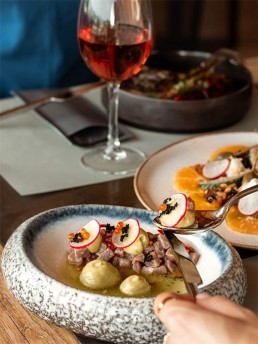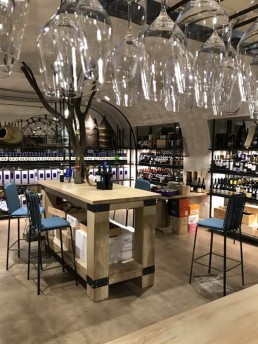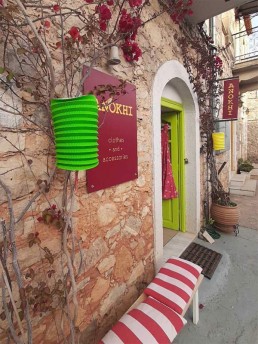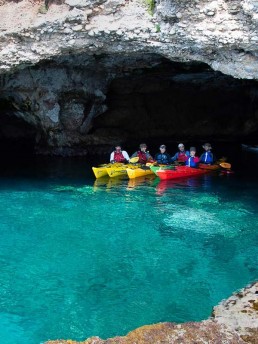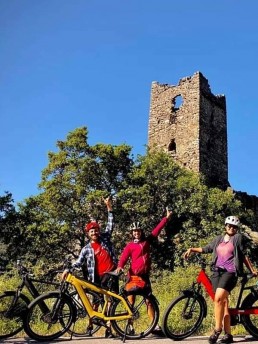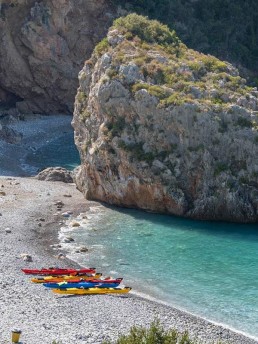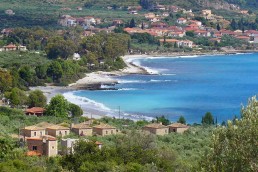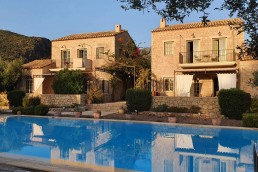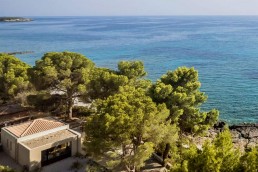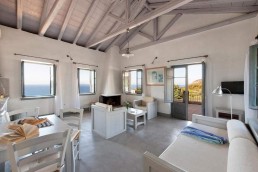
By Michael Cullen, Director
I first visited Kardamyli in 1990, and I’ve returned almost every year since. If that’s not a ringing endorsement, I don’t know what is! Initially I came as a hiking guide, leading small groups across its spectacular mountains and gorges; then alone, writing and updating my guidebooks to the region; latterly with my extended family, for magical multi-gen doses of autumn sunshine, sea swims and starlit dinners. And still I never tire of it.
JUMP TO: WHEN TO GO | BEST HIKES | BEST EATS | WHERE TO STAY
Why Kardamyli?
This gorgeous little town – really an overgrown fishing village – in the Outer Mani region south of Kalamata has a magical setting between soaring mountains and sparkling seas. Snowmelt from Mt. Taygetos’ 8000-ft peaks feeds a landscape of silvery olive groves, deep limestone gorges, amazing wild flowers and hilltops dotted with Byzantine chapels. It’s a walker’s delight.
The village itself – just 500 people, double that in summer – has been beautifully preserved: handsome stone houses with tiled roofs and flowering gardens, many of them tastefully converted into boutiques, tavernas or guesthouses. There’s a 17th century tower and church too, plus the mythical graves of Castor and Pollux. As for the seafront, it’s mostly rocky – perhaps Kardamyli’s saving grace – with an offshore islet protecting an enclosed harbour where boats bob and waterfront eateries twinkle beneath the atmospheric chimney of a former olive soap factory. West from town stretches a half-mile pebble beach; it’s never crowded. The vibe is gentle and contented – no wonder that the late, legendary travel writer and war hero Patrick Leigh Fermor chose this spot as his home.
And why the Peloponnese?
Because you get miles of spectacular Greek coastline without the need for ferries (just drive from Athens; it’s not far); plus a rich, wooded interior dotted with ancient sites including Mycenae, Epidavros and Olympia. The handsome towns of Nafplio and Sparta provide a dose of semi-urban buzz, while the southerly Mani peninsula offers remote coves and rugged mountains. At 20,000 km2 (the size of Wales), the Peloponnese is big enough to explore for two weeks, or even two months, without running out of adventure.
Kardamyli through the ages
Everywhere in Greece is steeped in history, and Kardamyli is no exception – though it wears it lightly. In The Iliad, Homer mentions the town, then one of Sparta’s ports, as part of the reward offered to Achilles by Agamemnon to rejoin the Trojan war. In medieval times, like much of the Mani peninsula further south, it was heavily fortified as rival clans battled for supremacy: some of their tower houses still stand.
Under Frankish auspices, countless countryside chapels were built and painted with vivid frescoes – some still preserved (if you can find the key) – showing gory martyrdoms and semi-pagan symbolism. And in the 19th century, the Maniots were part of the earliest armed uprisings against the Ottoman Turks – the expression of a rebellious spirit on which they still pride themselves.
When to visit Kardamyli
Peak season is July and (especially) August, when lots of wealthy Athenians descend en masse – it’s been earning a bit of a name amongst the Greek glitterati recently, and the village’s prime bars have a touch of Ibizan vibe; but it’s never as crowded as the main Cyclades islands, for example. Couples wanting a sunny but quieter escape should choose June or September. For walkers the best times are April and early May (wonderful wild flowers) or October (lovely sea swimming). November brings the olive harvest, which occupies almost everyone hereabouts – a fun time to visit, if you can find someone (without any olive groves) who’s willing to put you up and feed you.
Two events worth bearing in mind are the Kardamyli Jazz Festival in May, a super-friendly and informal Norwegian-run programme of jazz, blues and light rock gigs in small venues around town; and the Literary Festival in October, which brings together top-level speakers from literature and politics (the likes of Rory Stewart, Bettany Hughes, Neil MacGregor and Tom Holland) in a really intimate environment (only 350 attendees).
Best hikes
There’s a wonderful variety of routes, from stone-laid coastal mulepaths to rocky gorge clambers to high forested summits, depending on the time of year and your energy levels. Route-finding can be tricky, so make sure you have the Anavasi map or a trail app to hand; ideally also the Sunflower Peloponnese guidebook for background and further hikes.
A good starter is the 2-hour Petrovouni – Agia Sofia loop walk. From Kardamyli’s town hall (dymarcheio) at the southern end of town, follow the road inland signed ‘Petrovouni 3’. After 750m (15min), by a green sign, turn left up the zigzagging kalderimi (mulepath) – enjoying lovely views back over the bay – to the first house in the small hamlet of Petrovouni. Here follow a track left into the shady valley and keep left again, past a walled spring, following yellow and black waymarks. The small path curls rightwards into a second valley, which you cross and, keeping left, climb to reach a broader path. For the scenic (but usually locked) chapel of Agia Sofia, turn right and then, by another walled spring, right to reach the hilltop chapel, with 360-degree views from Mt. Taygetos’ summit round to the sea. Return and continue down the broader, stony path to Kardamyli. At a left bend you may spot two rectangular openings cut into the rock: supposedly the graves of Castor and Pollux (the Gemini or Dioscouri), one mortal and the other divine: the story’s worth looking up. Continue through an arch into old Kardamyli, by the graceful church of St. Spyridon and the imposing tower of Mourtzinos.
A more adventurous option is the 4-hour hike from Kambos back to Kardamyli. Route-finding can be tricky, so make sure you have the Anavasi map or app to hand, or the Sunflower guidebook. Take the morning bus (usually around 8.15) towards Kalamata – it picks up by the cafe near the village church – and alight after 30+ minutes in the village of Kambos (ask the driver if in doubt). From the stop by a right-angle bend, walk back 20 metres and turn right at the 12th-century church of St. Theodore on your right (usually open, with some interesting frescoes). After the school turn left, leave the village on a path and, keeping left, cross a ditch to reach a collapsed Myceanean ‘beehive’ tomb, supposedly that of Machaon, son of Asclepius. Nearby is the crumbling mansion of a 19th-century Prime Minister, Alexandros Koumoundouros. Rejoin the road, turn right and (after 50m) left up a rough track; keep left then fork right – it dwindles to a path – climbing to a small lane. Up to your right is the ruined Frankish keep of Zarnatas, a worthwile 10-minute detour for its fabulous views over olive studded hills to the summits of Taygetos. Follow the lane left (SW), past the church of Malta village, to the main road. Turn right and immediately left, then fork left up a rough track which soon descends into the wild maquis-covered valley and bay known as Velonas. You can cut some corners on the old kalderimi. Keep your eyes peeled for blue and yellow waymarks on your left because, at a seemingly random point 100m before a right bend, you have to scramble up the left bank to find a lovely old stone-laid path. This takes you back over a crest amd down – crossing a gravel track multiple times – to reach the edge of Kardamyli by Notos Hotel. Turn right for Elies Hotel and the beach.
Finally, a fun but challenging and remote gorge walk, including the spectacular Pigadiotiko bridge and cleft. You’ll need a map, food, plenty of water, and agility. Park by the remote chapel of Agii Aposotoli between Anatoliko and Voreio Gaitses. Follow the track down (west) for 100m, then turn right (NE) down a smaller track descending all the way down to the Rindomo gorge. At the bottom, turn right along the gorge bed, looking for cairns and red waymarks for the best routes over, around or occasionally under the sometimes sizeable boulders. Our teens had fun scrambling, but you do need to keep an eye, and your wits, about you. After about 3km (2 hours) of this, you pass through a dramatic narrow cleft: dark and eerie, with possible water pools. If you look up you may spot an ancient stone bridge – the Pigadiotiko yefiri – spanning the cliffs above. Where the cleft widens, turn sharp right up a steep path, passing that bridge and then a concrete bridge (don’t cross either). At the rough dirt road, continue straight on (S), contouring above the gorge you’ve just walked through, to reach the start point in about an hour.
Best beaches
If you’re looking for endless sands and beach parties, you’re in the wrong place: the coast here is mostly rocky and wild. But it’s stunningly beautiful.
Stretching north from Kardamyli, pebbly Ritsa beach has wonderfully clear waters (occasionally wavy) and a handful of summer bars with sunbeds. There’s decent snorkelling around the submerged ‘reefs’ at the far end. Heading the other way, Kalamitsi cove – below the Leigh Fermor house – is more sheltered, with sandy patches and gently swaying cypress trees.
It’s only a 10-minute drive to Stoupa, where you can get a dose of low-key beach-bar vibe. White-sand Kalogria is the most desirable, with idyllic (and child friendly) shallows, beach volleyball, SUPs to hire, a small dive school, and ranks of loungers. Almiriki Tavern will do you an excellent lunch, too.
Halfway between the two, Foneas feels like a pirate’s cove, with its steep overhanging cliffs and vast obelisk-shaped boulder (from which you can, with care, jump in). The water positively sparkles with reflected sunlight here. A small cafe operates in summer.
Best eats
You’re spoiled for choice in and around Kardamyli: superb traditional tavernas, seafood restaurants, wine bars and more. Friends of mine have arrived thinking they don’t like Greek cuisine (or Greek wines), and left loving them both.
The pioneer is Lela’s Tavern, with an unrivalled seafront position near the fishing harbour; sunsets are meltingly spectacular. Lela Yianakeas was Leigh Fermor’s housekeeper for many years, and perfected the writer’s favourite Greek dishes, including moussaka, kolokithopita (zucchini pie), slow roast pork and grilled octopus. Her menus passed to the next generation, who now run the place with a touch more sophistication (and excellent English), but no less charm. Booking essential; note it’s closed in August as well as mid-October to early May.
If it’s full, try seafront Harilaos nearby, for its excellent fresh fish (the grilled sardines are a must) and seafood (we loved the fried squid with fava and dill oil), as well as a multi-storey grilled veg with molten talagani cheese. Or neighbouring Tikla Cuzina has more soigné fare – artistic tapas, fine wines, chic stoneware and more of those mesmerising sea views.
For a change of scene, head to the far end of Ritsa beach where, amongst the olive groves, you’ll find open-air Elies. It’s a staggeringly beautiful spot for a post-swim lunch, or (from May-September) dinner under the stars. And chef-owner Fani also happens to produce some of the most delicious, succulent, authentic Greek cuisine that I’ve ever tasted (and having lived half my life in Greece, I’ve tasted plenty).
Fancy a night in? Grab an excellent pizza from Pizza Manina by the supermarkets: the dough is super-crisp and light, the toppings fresh and original (try fig and gorgonzola!). Or there’s proper, no-frills souvlaki at Kalamaki Souvlaki Bar. Takeaway or eat in (there’s an olive-shaded garden to the rear), it’s the kind of place you just help yourself from the drinks fridge and they tot it up at the end.
Finally, if you’re in Stoupa, the pick of the tavernas is Almyriki (on Kalogria beach) – whether grilled mullet or snapper, tuna with orange dip, local lamb with oregano, black-eye bean salad, or a classic tomato-feta-cucumber, we’ve never had a bad dish there.
Best Shops
For Greek wines and olive oil – to take home, or try before you buy – you can’t beat Psaltiras. Nikos’ knowledge is unrivalled, the vibe urbane, and he’ll offer you a platter of cheese or cold cuts while you taste and ponder.
My wife loves browsing the women’s summer wear and accessories at Anokhi on the main road. Meantime I nip into Equinox bookstore and check if any new guides have appeared to the area (there are interesting publications on local herbs and cuisine); or I chat to the staff at 2407m about hiking and biking trails, while surreptitiously browsing their latest backpacks.
Best excursions
Talking of backpacks, the guys at 2407m can organise bespoke mountain adventures, including an ascent of Taygetos’ summit (after whose altitude the shop is named), or the slightly lower but more accessible Anina. They also offer some memorable e-bike tours (we loved the sunset one), and hire out all manner of two wheelers: MTB, racer, gravel and kids’ bikes. But take it from us: you want an e-bike.
If you’re more of a sea baby, try the kayaking tours arranged by Explore Messinia: starting from the fishing harbour you’ll visit a translucent blue sea cave, the islet of Meropi and several secret swimming spots.
